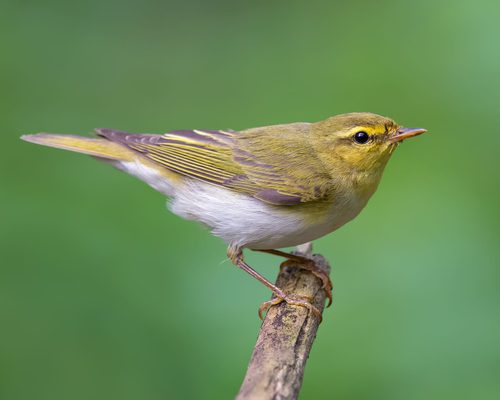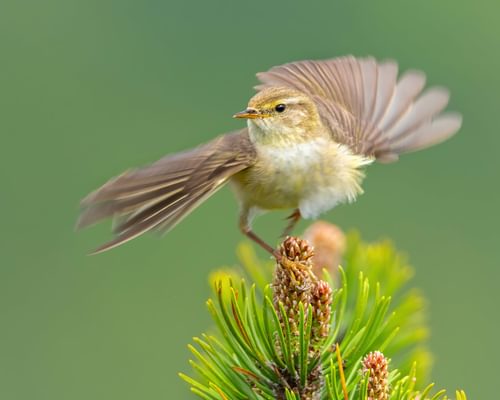Chiffchaff
Least ConcernPhylloscopus collybita
Visual Identification
Appearance
The Chiffchaff is a small, olive-brown warbler with a pale eye stripe and faint wing bars. Its underparts are typically pale with a yellowish tinge, while the upperparts are olive-green to brown. The bird has short, rounded wings and a slightly forked tail.
Males and females are virtually identical in appearance, with females being slightly smaller on average. Juveniles closely resemble adults but may appear slightly duller and more yellow-tinged overall.
Size
Length
10cm to 12cm
Wingspan
15cm to 21cm
Weight
6g to 10g
Colours
Males and females have similar plumage
Primary Colour
Olive Brown
Secondary Colour
White Yellow
Beak Colour
Brown
Leg Colour
Dark Brown Black
Habitat and Distribution
Habitats
Woodland
Garden
Wetland
Coastal
Urban
Farmland
Grassland
Desert
Tundra
Rainforest
Mountain
Savanna
Distribution
Chiffchaffs inhabit many wooded habitats, including deciduous and mixed forests, parks, gardens, and hedgerows. They are widespread across Europe and Asia, with populations extending from Western Europe to Eastern Siberia.
In the UK, Chiffchaffs are common summer visitors and increasingly year-round residents in southern areas. Some populations migrate to the Mediterranean and North Africa for winter, while others have begun overwintering in their breeding grounds, likely due to climate change.
Elevation Range
Sea level to 3,300 meters
Climate zones
Temperate, Subtropical
Distribution Map
This map gives you a rough idea of where you might spot a Chiffchaff. The coloured areas show countries where these birds have been seen.
A few things to keep in mind:
- Birds might not be everywhere in the coloured areas, for example, they may be present around the coast of that country
- Where birds live can change with seasons and available food
- This map is quite simple - it doesn't show exact locations
We're working on making our maps even better! Soon, we hope to show you:
- More detailed maps for bigger countries, including state and region
- How birds move around during different seasons
Distribution by Region
Behaviour and Ecology
Bird Attributes
This feature is in beta. We'd love your feedback to improve it!
Share your thoughtsBird Attributes Explained
Our bird attributes system rates various aspects of a bird's capabilities on a scale of 0-100, based on data from field observations, scientific studies, and expert knowledge.
Attribute Categories:
- Agility: Manoeuvrability, speed, and grace in flight or movement.
- Strength: Physical power, often correlating with size and hunting abilities.
- Adaptability: Ability to thrive in various environments or changing conditions.
- Aggressiveness: Territorial behaviour and assertiveness, particularly during breeding seasons.
- Endurance: Stamina, often seen in migration patterns or foraging behaviours.
Understanding the Ratings:
- 0-20: Very Low
- 21-40: Low
- 41-60: Average
- 61-80: High
- 81-100: Very High
Remember, these attributes are relative to other bird species and don't necessarily indicate superiority.
Hover over the icon next to each attribute for more information.
Tap the icon next to each attribute for more information.
Agility
Reflects the bird's manoeuvrability, speed, and grace in flight or movement.
The Chiffchaff displays remarkable agility, constantly flitting through foliage and even hovering whilst foraging for insects. Its restless nature and ability to navigate dense vegetation with ease justify a high agility rating.
Strength
Indicates the bird's physical power, often correlating with size and hunting abilities.
As a small warbler weighing only 6-10 grams, the Chiffchaff's strength is limited. Whilst capable of long-distance migration, its physical power is modest compared to larger birds.
Adaptability
Represents the bird's ability to thrive in various environments or changing conditions.
Chiffchaffs demonstrate exceptional adaptability, thriving in various wooded habitats from sea level to 3,300 metres. Their ability to adjust migratory patterns in response to climate change further showcases their adaptability.
Aggressiveness
Measures the bird's territorial behaviour and assertiveness, particularly during breeding seasons.
During breeding season, male Chiffchaffs become quite territorial, vigorously defending their areas with persistent singing and aerial displays. However, they are not known for extreme aggression towards other species.
Endurance
Reflects the bird's stamina, often seen in migration patterns or foraging behaviours.
Despite their small size, Chiffchaffs exhibit impressive endurance. They undertake long migratory journeys and maintain constant activity while foraging. Some individuals have been recorded living up to 8 years in the wild, indicating good stamina for their size.
Diet
Chiffchaffs are primarily insectivorous, feeding on various small insects and spiders. They glean prey from leaves and branches, often hovering to snatch insects in mid-air, as well as on the ground.
They may supplement their diet in autumn with small berries and fruits, especially during migration. Their normal daily intake of flies will usually be equal to a third of their body weight.
Behaviour
Chiffchaffs are restless and active birds, constantly flitting through foliage in search of insects. They often hover while foraging, a distinctive behaviour among warblers.
During the breeding season, males become highly territorial, vigorously defending their areas with persistent singing and occasional aerial displays.
Vocalisation
The Chiffchaff's name is onomatopoeic, derived from its distinctive song: a repetitive 'chiff-chaff' or 'zilp-zalp'. This simple yet persistent call is often the first sign of spring in many European woodlands. They also have a soft 'hweet' call that is used for contact and alarm.
Nesting & Breeding
Chiffchaffs typically form monogamous pairs during the breeding season, which runs from April to July in most of Europe. Males establish territories and attract females with persistent singing.
The nest is a domed structure made of grass, leaves, and moss, usually located close to the ground in low vegetation or brambles. Females lay 5-6 white eggs with dark speckles.
Incubation lasts about 13-14 days, and the female primarily performs it. Both parents feed the chicks, which fledge after 12-15 days. Pairs often raise two broods per season in favourable conditions.
Lifespan
The Chiffchaff typically lives for 2 to 3 years, with a maximum recorded lifespan of 8 years.
Like all birds, lifespan can be affected by factors including predation, habitat quality, disease, and access to food sources.
Conservation and Status
Global Conservation Status
While the Chiffchaff is currently listed as Least Concern, it faces threats from habitat loss and climate change. Conservation efforts focus on preserving woodland habitats and monitoring population trends across its range.
It benefits from protection under the Wildlife and Countryside Act in the UK.
Birdwatching Tips
- Listen for the distinctive 'chiff-chaff' call, especially in early spring
- Look for constant movement in the lower to middle levels of trees
- Watch for tail-wagging behaviour, which is characteristic of the species
- In the UK, check deciduous woodlands and parks from March to October
- Observe their hovering behaviour while foraging for insects
Additional Information
Quick Facts
Other names:
Common Chiffchaff
Family:
PhylloscopidaePredators
Did You Know?
- Chiffchaffs are one of the earliest spring migrants to return to Northern Europe, often arriving in March.
- Some Chiffchaffs have been recorded living up to 8 years in the wild despite their typically short lifespan.
- The species has shown remarkable adaptability to climate change, with some populations changing their migratory patterns.
Was this bird profile helpful?
Your feedback helps us improve our content
Thanks for your feedback!
Your input helps us improve our content.
Community Experience
Community Ratings
No ratings yet - be the first to rate this bird!
Latest Community Reviews
No reviews yet
Sign in to be the first to review
Community Reviews
Create Your Free Account Welcome Back!
Join our community to rate birds and share your experiences. Creating an account is completely free and only takes a minute. Sign in to your account to rate birds and share your experiences with our community.
Your information is secure and will never be shared.
By creating an account, you agree to our Privacy Policy.
Similar Birds
References
- 2 3
website: BirdLife International. 2019. Phylloscopus collybita (amended version of 2017 assessment). The IUCN Red List of Threatened Species 2019: e.T103843725A155613186.
View source - 4
report, 2015: EBCC
- 1
website, 2010: Fransson et al., EURING list of longevity records for European birds
View source

